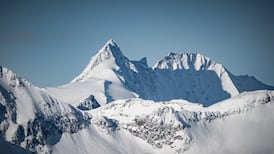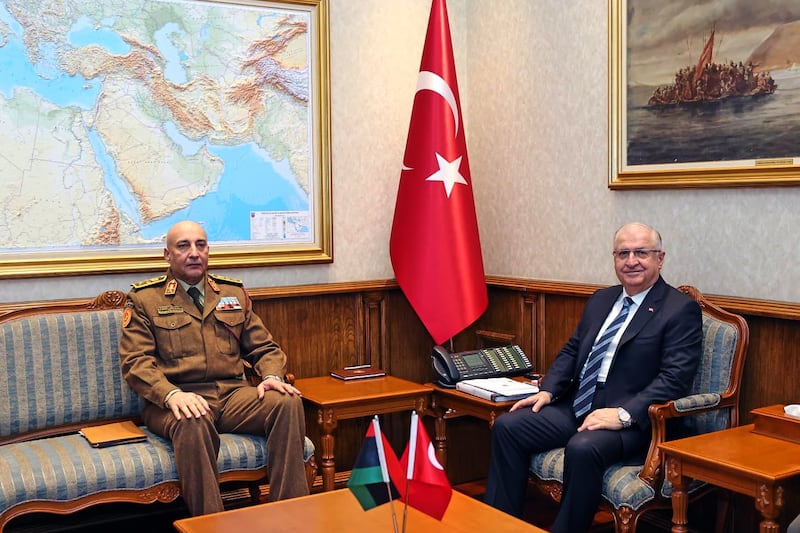The wooden ship had been at sea for almost 12 hours when those on board first sighted the crew of the Geo Barents, operated by medical charity Médecins Sans Frontières (MSF), which was speeding towards them on an orange rigid inflatable boat.
They waved, grinning widely. Then one pulled out his phone and posed for a selfie.
On board were 26 men – all from Bangladesh, apart from one Egyptian. They had been spotted on the waves by the Sea Bird 2, a small plane operated by German rescue organisation Sea Watch.
It was shortly after 8am in the Central Mediterranean, and this was the second rescue that the MSF crew had carried out. The first 45, taken off a fibreglass boat, were also mostly Bangladeshis, along with four Pakistanis and two Syrians.
READ MORE
The fact that so many people had already travelled thousands of miles to reach this dangerous spot in the Central Mediterranean may seem strange, but it is no longer surprising. In the first seven months of 2024, Bangladeshi people made up almost 22 per cent of all sea arrivals in Italy, the highest of any nationality, with 7,288 arrivals. Syrians were the next highest at 16.3 per cent; Tunisia came third; Egypt fourth; and Guinea fifth.
Many say they know the sea can be dangerous – more than 30,000 people have died or gone missing on the Mediterranean Sea trying to reach Europe over the last decade – though they were not as aware of the abuses they would face beforehand, in Libya.
Through interviews with people on board both boats, it was possible to trace their earlier journeys.
Some only left Bangladesh this summer, but others had been travelling for years. One explanation for differences in their treatment, suggested Mark Micallef, director of the North Africa and Sahel Observatory at the Global Initiative Against Transnational Organised Crime, could be that people are “typically divided between those who go for a pay-in-advance whole package and those who don’t”. Those who need to work and earn money along the way to afford further passage are more vulnerable to abuse and exploitation at every leg, he said.
The journey from Bangladesh to Europe can be considered “hybrid smuggling,” as parts are legal or “semi-legal”, said Micallef. The growth in Bangladeshis is partially related to there being “opportunity and the right criminal entrepreneurs” who become smugglers. There were estimated to be tens of thousands of Bangladeshi workers in Libya before the 2011 civil war, meaning they have a long foothold in the country.
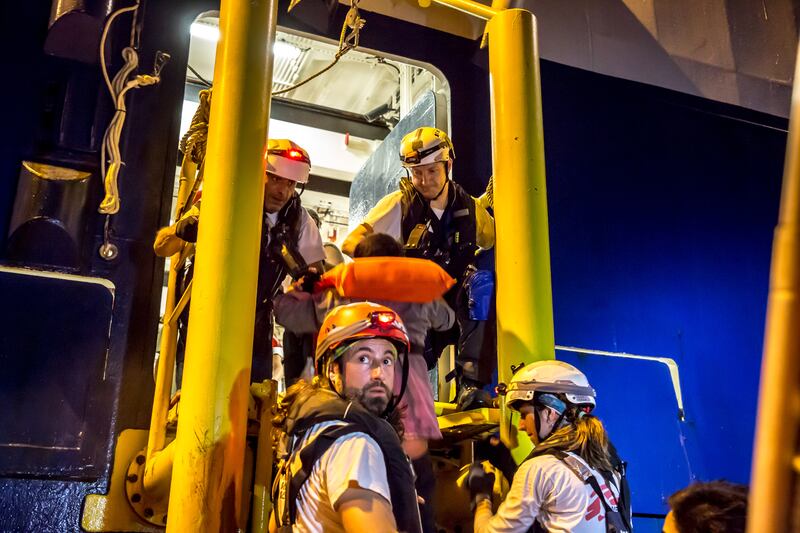
In interviews on board the Geo Barents, a group of five men sat in a circle on the ground to talk about what they had gone through. Their names have been changed for security reasons and so they could speak freely.
Their stories from Libya kept returning to one name in particular: Osama. When shown old photos, several appeared to identify him as an infamous human trafficker, operating in Libya, who is known as Osama Al Kuni Ibrahim, or Osama Milad. That man has been under international sanctions since 2021, accused of engaging in or providing support to “acts that violate applicable international human rights law, or acts that constitute human rights abuses in Libya”.
One interviewee also picked out Abd al-Rahman Milad, known by his alias Bija, from a group picture. He said Bija – who has held the position of local commander of the Libyan coastguard, and is also under international sanctions – was regularly with Osama. It was not possible to contact either man for comment.
The interviewees’ accounts of being held for ransom and exploited also bore similarities with previous accounts The Irish Times has been hearing since 2019 from people of other nationalities who were held by Osama, even if their initial reasons for leaving home were different.
Reza (37) said he travelled to Libya to make money after the expense of his wedding ceremony. He worked as a painter until he was kidnapped at gunpoint in the street and held for ransom. His family sold farming land to pay $10,000 to the first trafficker, who he identified as a Bangladeshi called Noori. He was then passed on to another Bangladeshi person known as Suheil, who demanded $5,000 – money his family had to sell their home to raise.
Both Noori and Suheil are working under Osama, he said. Both were physically violent. Their captives were given little food and held in small spaces. “There is no AC, no fan in the cell, no light, nothing. They keep 100 people in one room, some sleep sitting up or spooning each other. We were drinking salt water in small quantities.” The fact that they had been sharing small spaces could have been evidenced by the fact that the vast majority of rescued people had scabies.
One guy wanted to run away and they shot him and threw him in the sea
Eventually, Reza said, Osama offered him a space in a boat heading towards Italy. “He’s giving us one option. If you don’t go, he’ll kill you.”
He also explained how the ransoms were paid. Bangladeshis inside Bangladesh, working with traffickers in Libya, visit the families of those kidnapped, he said. “They come to our homes and say ‘your son, your brother is with us, if you inform someone your brother will be killed’. They tell them to go to a place, like a market, alone, [and] their person will be there. They have to bring cash.”
He said some people in Libya were killed by the trafficking gangs. “One guy wanted to run away and they shot him and threw him in the sea.”
Pintu, aged 20, said he left Bangladesh because his family was heavily in debt due to medical bills. His father had been ill for two decades. “He can’t swallow or eat. He’s been hospitalised since 2015 in New Delhi.”
Pintu said they spent almost $30,000, borrowing a lot from people who began threatening the family. Pintu was just out of school, but he travelled alone to Dubai on a tourist visa, then on to Egypt and Libya. He used three separate “dalaal” or “travel agents”. In Dubai, he said, “there are a lot of Bangladeshi people in Dubai who are travelling like this”, so it’s not hard to find a smuggler.
He arrived in Libya in April 2022. He worked in a restaurant for eight months, but was only paid for two. Then he worked in a cake factory for six months. He says he had no plans to go to Europe, but the person who employed him handed him over to the smuggling group. He said Noori, who was working for Osama, locked him in a room and demanded $20,000. His parents sold their family home to pay, but he was held for two more months, then given to Suheil who asked for $5,000. His family sold their farming land.
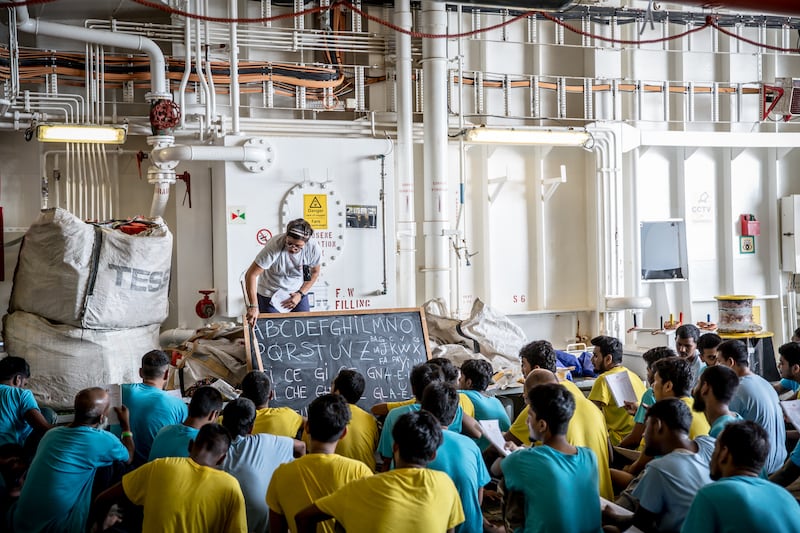
Pintu says he was released after another seven months, when the trafficking gang realised no more money could be extracted from him. He went to the city of Misrata and found work as a mason, but was caught by “police” months later again, held for months by Osama and finally put on a boat.
He called Osama “the boss”, saying he believes around 80 per cent of the extorted money goes to him, and 20 per cent to the Bangladeshis working under him. The description of how human smugglers and traffickers in Libya recruit nationals from other countries, specifically to exploit and lure in people of the same nationality, aligns with similar testimonies that The Irish Times has collected over the past five years.
Ghulam (21) left Bangladesh in 2022, also after his family entered debt as a result of medical bills. It was both for his father, who has since died, and his brother, who is still alive. He travelled to Libya via Dubai, Kuwait, and Egypt, paying around €4,500 in total. He worked as a sweeper for three months, but was caught by police on the way to his accommodation and accused of not having legal documents. He said he was held in prison in port city Khoms for two months, then sent on to “Osama’s jail”, where he says he was “hanged from the ceiling.” After two months, he paid $10,000, raised from the sale of his family home. Then he paid another $5,000 to Suheil, and was offered a place on the boat.
Ghulam said there were Syrians, Nigerians, Egyptians, Bangladeshis, Pakistanis, and other Africans held with them – up to 800 people at a time. “If someone is dying they throw away the dead body in the sea,” he said.
Kamran (21) said he left Bangladesh after there was a dispute around his family’s farming land. When he filed a legal challenge, the opposing party made threats against him, forcing him to flee.
He went to Qatar and found an “agent” who said he would take him to Turkey to find a job. Instead, Kamran was taken to Syria, and then Libya, despite having paid more than €5,200. “He didn’t fulfil his promise,” bemoaned Kamran. He said he worked in Libya for seven months before “Osama’s mafia” caught him while he was drinking tea with friends. His family sold their land to pay the first $10,000, then another $4,500 was demanded, this time under Noori. He said he was held for around 15 months in total.
While they were under the control of the traffickers, all of the interviewees said, their phones were taken away – they were only given back right before they went to sea.
When the small wooden boat was finally leaving, they said Osama told them not to worry because the Geo Barents was nearby and would rescue them.
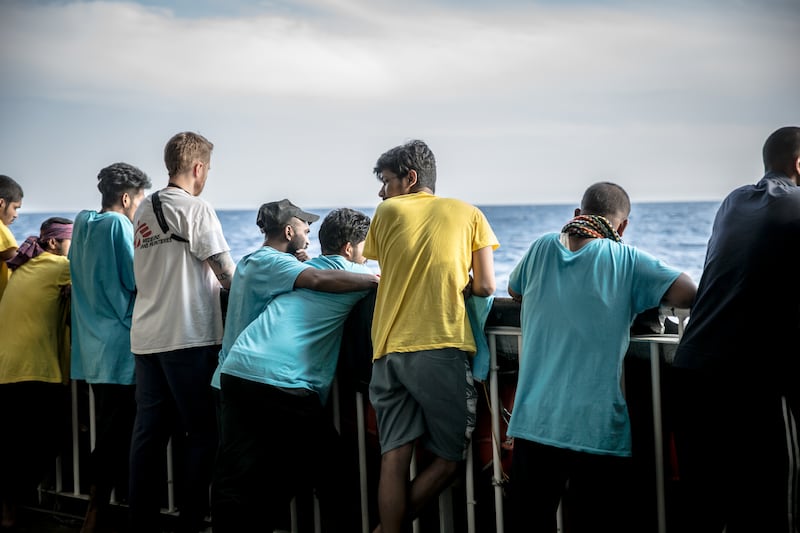
Like other vessels, the location of the Geo Barents can be seen on shipping apps such as MarineTraffic, with MSF saying that while they do not publicly communicate its location or itinerary, “maritime safety regulations oblige all ships above a certain tonnage to be equipped with automated identification system (AIS) transceivers that transmit data to AIS receivers. As such, all ships can be tracked on vessel traffic services, electronic charts and publicly accessible vessel tracking websites. The position of Geo Barents thus is, and must be, always publicly accessible to anyone with internet access.” This highlights one of the challenges NGO search and rescue vessels have, that they can be accused of being used by people smugglers, though they say that those on the small boats are clearly in a desperate situation, they usually personally have no choice about when they go to sea, and that not to take them on board, when they find them in the water, could mean they die there or would be forced back to a place where their lives are clearly at risk. Charity rescue ships only account for around 8 percent of asylum seeker arrivals in Italy, the Associated Press said in January.
While those five interviewees all said they were held under Osama, some of the people who went to sea in the other boat, and ended up on the MSF’s Geo Barents, spent a lot less time in Libya, and travelled with other smugglers who they were unwilling to name. Some, like Fahim, also said they were not mistreated, though he had dangerously gone a month without his diabetes medication.
The 65-year-old’s story showed how Bangladeshis of all ages are feeling pushed to make the journey to Europe, which some refer to as “the game”.
[ How has the mass drowning of people become normalised?Opens in new window ]
Fahim spent 25 years in Saudi Arabia working as a painter, before moving back to Bangladesh with the belief that he had enough money to set up a business. He started a brickmaking factory, which lasted for a decade until the Covid-19 pandemic hit. As business slowed, he took a loan from the bank, giving his home as a guarantee. Another problem emerged: he couldn’t get a permit for charcoal any more, which he needed to make bricks, so he sold his second home in his familial village.
We can’t tell what will happen but we hope things will get better
He travelled to Saudi Arabia, where he wanted to work as a painter again but couldn’t get the correct visa. In Dubai, Fahim “met someone who took my money” and sent him to Libya. He worked there for seven months, before paying 700,000 Bangladeshi taka (€4,437) for a seat in a boat. One month later, they travelled. “A Bengali person told me to follow these men and I did.”
All along, Fahim said, he dealt with Bengali travel agents or smugglers. In Italy he was hoping to work, but he wondered how much he could do. On top of diabetes, he has an eyesight problem. On his big toe, a large gash was visible. His eyes welled up with tears as he considered where he was and what he had been through. Back in Bangladesh, Fahim has two “unmarried daughters” and a wife, he explained, trailing off. He became more upset and we stopped the interview.
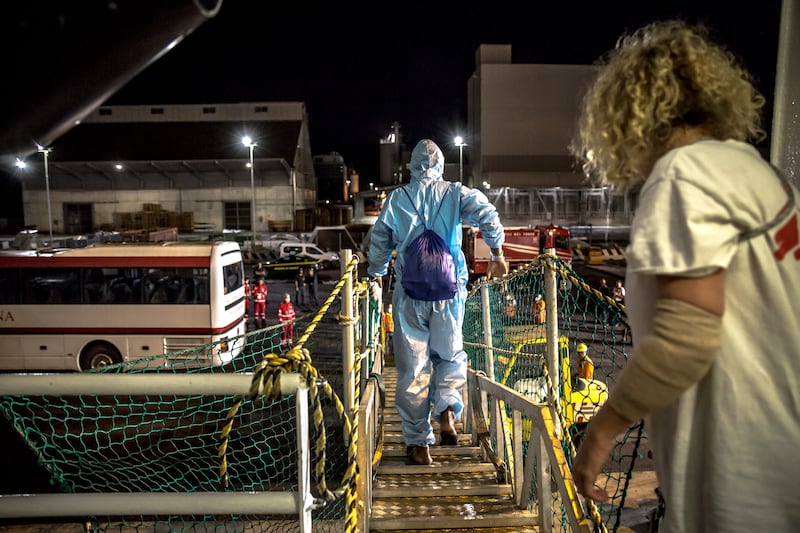
In terms of land mass, Bangladesh is just over twice the size of Ireland, but its population is roughly 170 million. They are facing huge challenges.
Climate change is driving urbanisation and pressure on resources; an unstable political situation means it is hard to grow a business or plan a future; global inequality means that even a poor wage abroad can support a family back home. In 2022, remittances to Bangladesh were worth $21.5 billion dollars, making up 4.7 per cent of the country’s GDP, according to the World Bank.
Recently, 4.5 million Bangladeshis have been affected by flooding, with nearly 190,000 people taken to emergency relief shelters this month. Extreme weather is likely to continue, with climate experts saying rising sea levels and coastal erosion could lead to a loss of 17 per cent of the country’s land surface and 30 per cent of food production by 2050.
The group of Bangladeshis who came aboard the Geo Barents in August were making the journey at an especially pivotal time for their country: two days after they were rescued from the sea, 76-year-old autocratic prime minister Sheikh Hasina resigned and fled the country, following months of violent protests. Her rule, which began for a second time in 2009, was marred by forced disappearances, extrajudicial killings and the detention of opposition and activists. Afterwards, reports suggested that she would now seek asylum too.
As soon as he heard Hasina was gone, one young man started to praise Allah, holding his hands up towards the sky. Others grinned widely, then looked worried, debating what might happen next.
When MSF staff printed out a news article about the latest developments in Bangla, those on board defaced Hasina’s picture, putting an X through her face, and drawing on a beard and moustache. A new prime minister, Nobel laureate Muhammad Yunus, was appointed on August 6th. Yunus is a microfinance pioneer, though it remains to be seen how his leadership might change the country. While its proponents have said it provides opportunities to the world’s poorest, critics accuse microfinance of actually trapping vulnerable people in debt cycles.
“We can’t tell what will happen but we hope things will get better,” said Reza, reflecting on the news.
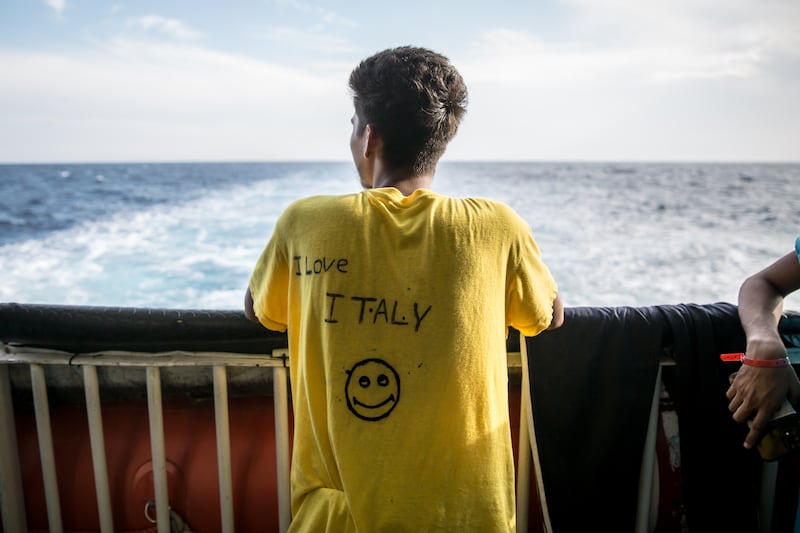
Today, Bangladeshis make up one of Italy’s largest immigrant populations, with more than 162,000 legally residing there in 2023, according to government figures. But the future for those who travel irregularly is not certain: Bangladesh was this year added to Italy’s list of so-called “safe countries,” and they are unlikely to be granted asylum.
During the days that it took to sail to Ravenna, the “place of safety” designated by Italian authorities, MSF staff advised those on board of their legal rights, warning them also to look out for future attempts by criminal gangs to exploit or traffic them inside Europe. But this did not temper their good mood, with some even writing “I love Italy” in marker on the yellow T-shirts they had been given. The rescued people were also allowed to send a single SMS message to their family or friends. The wording was formulaic.
“This is a message from Médecins Sans Frontières-Doctors Without Borders, medical and humanitarian organisation. We would like to inform you that [name] has been rescued in the Mediterranean Sea and is now safe on board of our rescue ship. It may take several days before our ship reaches a safe place where [name] will be able to contact you. This is an automatic rescue notification, please do not respond, you will not receive an answer.”
Later, finally on Italian soil and with internet access again, a few posted photos from the ship on Facebook, attracting hundreds of likes and comments. It was a meaningful sign, too, that Bangladeshis back home had regained connection after nationwide internet shutdowns during the protests.
“Alhamdulillah ... Allah has fulfilled my heart’s desire. Allah has accepted my mother’s prayers. Arrived in Italy,” posted one.
“Congratulations”, came the responses. “I am happy brother.”
- Sign up for push alerts and have the best news, analysis and comment delivered directly to your phone
- Join The Irish Times on WhatsApp and stay up to date
- Listen to our Inside Politics podcast for the best political chat and analysis





